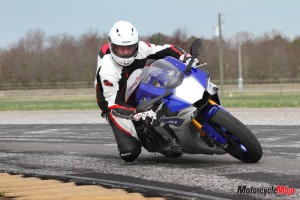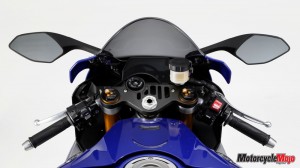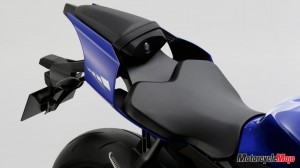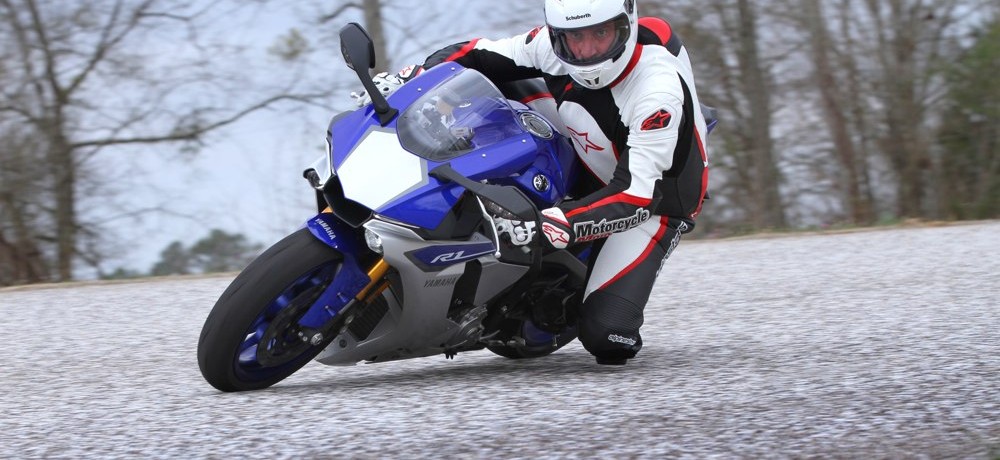The new MotoGP-derived Yamaha R1 comes with all the bells and whistles you’ve come to expect from a modern supersport machine – and more
Trust the electronics. This is something I began telling myself a long time ago, with the introduction of the first ABS system. It was the first rider aid, and it remained alone in helping riders stay upright until only a few years ago, when traction control was introduced. That prompted me to tell myself again to trust the electronics, and with time, I’m now comfortable with both of these electronic intervention systems.
Well, I recently had to remind myself again to trust a control system other than my own, when riding the 2015 Yamaha YZF-R1. It has ABS and traction control, as well as an all-new control system called slide control.
A Maturing Supersport
 The Yamaha YZF-R1 has been around for 17 years. When introduced in 1998, it raised the performance level of the few true open-class supersport machines, and it has been getting consistent upgrades ever since, on average about every two years. The R1 originally used a derivative of the 20-valve inline-four that Yamaha had introduced back in the 1984 FZ750, but has since reverted to a 16-valve inline-four. It is, however, distinguishable from its four-cylinder competition by the use of an odd-firing cross-plane crankshaft, with its twin-like power band and rich, offbeat exhaust note.
The Yamaha YZF-R1 has been around for 17 years. When introduced in 1998, it raised the performance level of the few true open-class supersport machines, and it has been getting consistent upgrades ever since, on average about every two years. The R1 originally used a derivative of the 20-valve inline-four that Yamaha had introduced back in the 1984 FZ750, but has since reverted to a 16-valve inline-four. It is, however, distinguishable from its four-cylinder competition by the use of an odd-firing cross-plane crankshaft, with its twin-like power band and rich, offbeat exhaust note.
This year, it enters its eighth generation, and it’s an entirely new machine, receiving more changes than any previous generation. Yamaha claims this latest R1 is more focused on the racetrack than ever before, borrowing heavily from the YZR-M1 MotoGP machine. Revised styling includes a very distinctive fairing that looks headlightless, and the under-tail exhaust has finally moved to below the bike, something other manufacturers have already done, because it makes the exhaust system lighter and moves the weight lower in the chassis.
Yamaha Canada extended an invitation to ride the 2015 R1, and its higher-spec brother, the R1M, at a small, tight racetrack just outside Birmingham, Alabama, called Talladega Gran Prix.
The new 998 cc engine continues to use the cross-plane crankshaft, but now uses a larger bore and shorter stroke, while the engine is 33 mm narrower and 4 kg lighter. European specs put power output at 197 hp at the crank, matching the new BMW S1000RR. Peak torque is 83.2 ft-lb at 11,500 rpm, which is the open-class inline-four average, except that the R1 has a very broad power band. Transmission ratios have been reshuffled, with first through fourth gears being slightly lower, and fifth and sixth slightly higher than before.
Steering geometry has been tweaked to improve corner entry, turning transitions and front-end feel. The fully adjustable suspension components on the R1 come courtesy of KYB, while the R1M uses an electrically adjustable semi-active suspension from Öhlins.
Lean-Sensing Electronics
 And then there are the electronics, which are now at a level required on machines approaching 200 hp. There are nine levels of lean-angle-sensing traction control, there’s three-level wheelie control, two-level launch control, and semi-linked cornering ABS (the rear brake works independently). Those are the rider aids. Then there’s the racy stuff, like a two-level quick shifter, four selectable power modes. But there’s also that one electronic aid that is unique – for now – to the R1: three-level slide control. All of the rider aids can be turned off, they’re managed through a new, configurable 10.6 cm TFT colour display. That’s a lot of electronics, which would otherwise be a convoluted mess to sort through when selecting modes and adjusting settings, but Yamaha has done a stellar job of making the user interface remarkably simple.
And then there are the electronics, which are now at a level required on machines approaching 200 hp. There are nine levels of lean-angle-sensing traction control, there’s three-level wheelie control, two-level launch control, and semi-linked cornering ABS (the rear brake works independently). Those are the rider aids. Then there’s the racy stuff, like a two-level quick shifter, four selectable power modes. But there’s also that one electronic aid that is unique – for now – to the R1: three-level slide control. All of the rider aids can be turned off, they’re managed through a new, configurable 10.6 cm TFT colour display. That’s a lot of electronics, which would otherwise be a convoluted mess to sort through when selecting modes and adjusting settings, but Yamaha has done a stellar job of making the user interface remarkably simple.
Unexpectedly, and rather gratifyingly, I was to share the track with only one other journalist for the day, and the weather was cooperating with sunny skies and warm temperatures. I began the day on the standard R1, and set the traction control to its most intrusive setting, just to see what it felt like. It felt exactly as expected: absolutely normal and invisible. Power mode was set to level 3, which permitted full power (level 4 limits overall output), but with a very smooth power delivery. Twisting the throttle hard while exiting corners provided very strong yet smooth acceleration. The only indication that something was managing the throttle other than me was the flashing TC light in the dash, which flashed almost constantly until the bike straightened out. Otherwise, by the seat of my pants, everything felt normal.
 Turning it up to the most aggressive level 1, the R1 felt like a true open-classer, and a brutish one at that. Power doesn’t come on with the explosive blast of the Panigale 1299, but the bike feels as though it has a much stronger bottom end than the BMW S1000RR or the Honda CBR1000RR, which I had also ridden recently. I also turned down the traction control to level 6 and again felt nothing out of the ordinary, except that the TC light was now illuminating less frequently, despite the more forceful corner exits. With each successive session, I turned the TC to lower settings, eventually settling on level 3, which provided very forceful corner exits, with the TC light only flickering occasionally, and only in a couple of corners.
Turning it up to the most aggressive level 1, the R1 felt like a true open-classer, and a brutish one at that. Power doesn’t come on with the explosive blast of the Panigale 1299, but the bike feels as though it has a much stronger bottom end than the BMW S1000RR or the Honda CBR1000RR, which I had also ridden recently. I also turned down the traction control to level 6 and again felt nothing out of the ordinary, except that the TC light was now illuminating less frequently, despite the more forceful corner exits. With each successive session, I turned the TC to lower settings, eventually settling on level 3, which provided very forceful corner exits, with the TC light only flickering occasionally, and only in a couple of corners.
Slide Control
The bikes were equipped with Bridgestone’s new RS10 radials, which provided exceptional grip and “feedback, though the track’s abrasive pavement wore them out before noon, so new rears were installed during the lunch break. Despite this elevated grip, the bike did begin to squirm a bit when pushed really hard through the corners, though things got very interesting as soon as the slide control was turned on, albeit in its most intrusive level 3.
Slide control uses the bike’s six-axis gyros and G-force sensors to override the traction control and allow the rear tire to spin up, while limiting that wheel spin to allow controllable slides. It was rather by accident that I discovered this, because I didn’t know the slide control was on the first time I actually used it.
During one of my later morning sessions on the R1M, I hammered the throttle exiting a long, third-gear left-hander that opened up at the exit, the way I had done in previous sessions. This time, though, the rear end stepped out, surprising me, but not enough to let up on the gas. The bike slid out and regained traction without incident, so I initially thought there was maybe a glitch in the TC. On the next lap, I gassed it even harder at that same corner to test the TC, which I had by now trusted, and the R1M slid out again, smoothly and for what felt like a long time before straightening out as I levelled out the bike. I discovered later in the pits that the slide control was on.
It was time to experiment even more. With the slide control again at level 3, hammering the throttle at corner exits instantly led to controlled rear-wheel slides, as long as I stayed on the throttle, which I dared not shut off despite my instincts yelling at me to do so. The slide control isn’t a feature that will make you lap any faster, nor will it actually teach you how to control the throttle in a slide, but it sure is fun to use!
Although the tight track didn’t initially seem adequate to test a near-200 hp supersport machine, it actually provided more info and allowed for more experimentation than a standard press launch at a super-fast European circuit would have, where track time is limited by much larger groups of riders.
Advancing With Its Peers
With the added horsepower and the extensive electronics package, the R1 is now on par in performance and technological advances with bikes like the BMW S1000RR, the Ducati Panigale 1299, the Kawasaki ZX-10R and the Aprilia RSV4 R. The only thing I found the R1 is missing is a downshift capability on the quick-shift system. After sampling this system on the BMW and Ducati, it has proven to be a very convenient rider aid that will actually help drop lap times. But it’s not a deal breaker, and between a quick-downshift feature and Yamaha’s slide control, I would take the slide control hands down.
This class-matching performance and technology comes at a price, and the 2015 YZF-R1 now costs $18,999, which is $4,000 more than it cost in 2014. The R1M costs another four grand above that. But that’s what a modern supersport with close to 200 hp and advanced electronics costs these days. And it seems that a number of sportbike riders don’t mind, because the R1M has already sold out. “

























